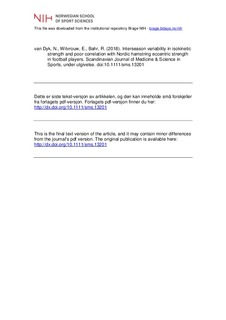| dc.contributor.author | van Dyk, Nicol | |
| dc.contributor.author | Witvrouw, Erik | |
| dc.contributor.author | Bahr, Roald | |
| dc.date.accessioned | 2019-04-04T13:06:23Z | |
| dc.date.available | 2019-04-04T13:06:23Z | |
| dc.date.created | 2018-05-16T13:06:45Z | |
| dc.date.issued | 2018 | |
| dc.identifier.citation | Scandinavian Journal of Medicine & Science in Sports. 2018, 28, 1878-1887. | nb_NO |
| dc.identifier.issn | 0905-7188 | |
| dc.identifier.uri | http://hdl.handle.net/11250/2593363 | |
| dc.description | I Brage finner du siste tekst-versjon av artikkelen, og den kan inneholde ubetydelige forskjeller fra forlagets pdf-versjon. Forlagets pdf-versjon finner du på onlinelibrary.wiley.com / In Brage you'll find the final text version of the article, and it may contain insignificant differences from the journal's pdf version. The definitive version is available at onlinelibrary.wiley.com | nb_NO |
| dc.description.abstract | In elite sport, the use of strength testing to establish muscle function and performance is common. Traditionally, isokinetic strength tests have been used, measuring torque during concentric and eccentric muscle action. A device that measures eccentric hamstring muscle strength while performing the Nordic hamstring exercise is now also frequently used. The study aimed to investigate the variability of isokinetic muscle strength over time, for example, between seasons, and the relationship between isokinetic testing and the new Nordic hamstring exercise device. All teams (n = 18) eligible to compete in the premier football league in Qatar underwent a comprehensive strength assessment during their periodic health evaluation at Aspetar Orthopaedic and Sports Medicine Hospital in Qatar. Isokinetic strength was investigated for measurement error, and correlated to Nordic hamstring exercise strength. Of the 529 players included, 288 players had repeated tests with 1/2 seasons between test occasions. Variability (measurement error) between test occasions was substantial, as demonstrated by the measurement error (approximately 25 Nm, 15%), whether separated by 1 or 2 seasons. Considering hamstring injuries, the same pattern was observed among injured (n = 60) and uninjured (n = 228) players. A poor correlation (r = .35) was observed between peak isokinetic hamstring eccentric torque and Nordic hamstring exercise peak force. The strength imbalance between limbs calculated for both test modes was not correlated (r = .037). There is substantial intraindividual variability in all isokinetic test measures, whether separated by 1 or 2 seasons, irrespective of injury. Also, eccentric hamstring strength and limb‐to‐limb imbalance were poorly correlated between the isokinetic and Nordic hamstring exercise tests. | nb_NO |
| dc.language.iso | eng | nb_NO |
| dc.subject | hamstring injury | nb_NO |
| dc.subject | isokinetic testing | nb_NO |
| dc.subject | muscle strength variability | nb_NO |
| dc.subject | nordic hamstring exercise | nb_NO |
| dc.subject | screening | nb_NO |
| dc.title | Interseason variability in isokinetic strength and poor correlation with Nordic hamstring eccentric strength in football players | nb_NO |
| dc.title.alternative | Interseason variability in isokinetic strength and poor correlation with Nordic hamstring eccentric strength in football players | nb_NO |
| dc.type | Journal article | nb_NO |
| dc.type | Peer reviewed | nb_NO |
| dc.description.version | acceptedVersion | nb_NO |
| dc.source.pagenumber | 1878-1887 | nb_NO |
| dc.source.volume | 28 | nb_NO |
| dc.source.journal | Scandinavian Journal of Medicine & Science in Sports | nb_NO |
| dc.source.issue | 8 | nb_NO |
| dc.identifier.doi | 10.1111/sms.13201 | |
| dc.identifier.cristin | 1585378 | |
| dc.description.localcode | Seksjon for idrettsmedisinske fag / Department of Sports Medicine | nb_NO |
| cristin.unitcode | 150,34,0,0 | |
| cristin.unitname | Seksjon for idrettsmedisinske fag | |
| cristin.ispublished | true | |
| cristin.fulltext | postprint | |
| cristin.qualitycode | 2 | |
